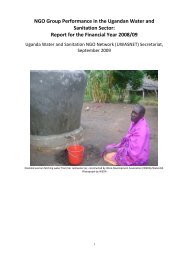Performance Report for FY 2009/10 - UWASNET
Performance Report for FY 2009/10 - UWASNET
Performance Report for FY 2009/10 - UWASNET
Create successful ePaper yourself
Turn your PDF publications into a flip-book with our unique Google optimized e-Paper software.
<strong>Per<strong>for</strong>mance</strong> <strong>Report</strong> <strong>for</strong> <strong>FY</strong> <strong>2009</strong>/<strong>10</strong><br />
Box 6.1: Reflecting on sustainability of rural water services: Source Triple<br />
–S Uganda<br />
On 4 th August 20<strong>10</strong>, it was reported in The New Vision that over 140 boreholes<br />
worth over UGX2.8 billion had been abandoned in Arua District after they broke<br />
down. Quoting the district Chief Administrative Officer, the report said that out of<br />
the 706 boreholes in the district, 146 were non-functional, while about 562 were<br />
operational but on their last legs. It’s inconceivable the number of people affected by<br />
the breakdown of 146 boreholes.<br />
Cases of non-functional rural water facilities abound. Statistics of Water and<br />
Environment Sector <strong>Per<strong>for</strong>mance</strong> <strong>Report</strong> 2008/<strong>2009</strong> indicate that functionality of<br />
rural water sources has stagnated at 80%-83% <strong>for</strong> the last five years. Meanwhile<br />
investment in new water sources continues. The Water and Environment sector<br />
per<strong>for</strong>mance report indicates that in 2008/<strong>2009</strong> alone, a total of 2,604 water points<br />
were constructed under the District Water and Sanitation Development Conditional<br />
Grant. In the same year, NGOs and CBOs collectively constructed 2238 rural water<br />
sources. This ensured access to safe water <strong>for</strong> an additional 900,000 people in<br />
rural areas. By <strong>2009</strong>, the rate of access to safe water in rural areas was at 65%, an<br />
increase from 63% in 2008.<br />
But with the non-functionality rate nearly 15%, there is a number of people who<br />
continuously lose access to safe water. Un<strong>for</strong>tunately, these are mostly in the rural<br />
areas. If not reversed, this trend is likely to result into the reversal of the gains<br />
that have been made in terms of access to safe water in rural areas. In its golden<br />
indicator No.2, the Ministry of Water and Environment commits to reach a target of<br />
90% functionality rate by financial year 2014/15. What strategies are in place to<br />
achieve, even over shoot that target?<br />
The challenge is not so much about raising the functionality rate to <strong>10</strong>0% as it is<br />
about addressing the impediments to sustainable functionality of water services.<br />
What are the impediments to sustainable rural water services?<br />
Sustainability is largely about community ownership of the water service. Communities<br />
have become disengaged from the process and ownership of the systems may be very<br />
low; politicians and local elites interfere, promising free water <strong>for</strong> all and undermining<br />
community ef<strong>for</strong>ts. In addition, there is the issue of user fees, which are hard to<br />
collect and are often abused by the collectors. Moreover the water user committees<br />
are voluntary which often demoralizes the members.<br />
Sustainability is also about technology choice. Technologies keep changing.<br />
Some may be modified to suit prevailing times while others may be overtaken by<br />
development and rendered obsolete. There is a whole host of problems associated<br />
with functionality of technologies including systems on their last legs; inappropriate<br />
technologies used; laxity in construction supervision; failing spare part chains; low<br />
quality of construction; inadequate operations and maintenance provisions; and<br />
vandalism. These all have a bearing on sustainability of water supply.<br />
Sometimes sustainability may be affected by the cost of production. For example,<br />
some areas have poor quality water and there<strong>for</strong>e, <strong>for</strong> every source developed<br />
treatment will be required. This makes the investment too high and simple technology<br />
is thus made complicated, which creates a sustainability problem.<br />
75 | NGOs in the Ugandan Water and Sanitation Sector



